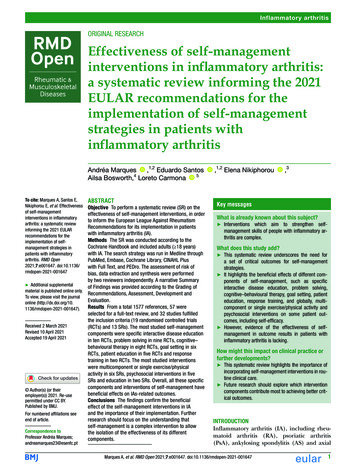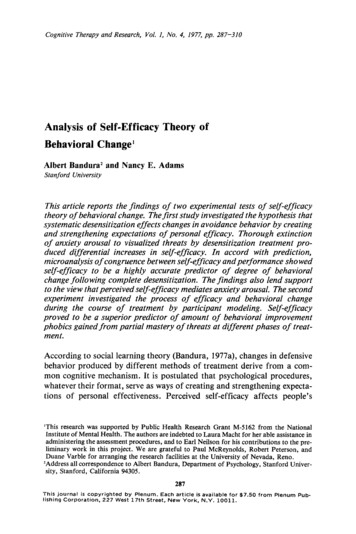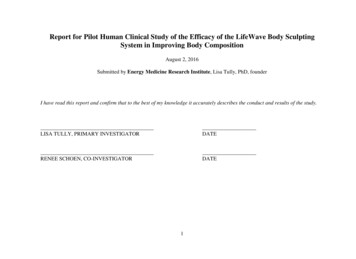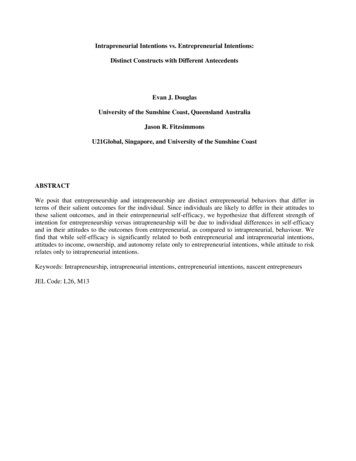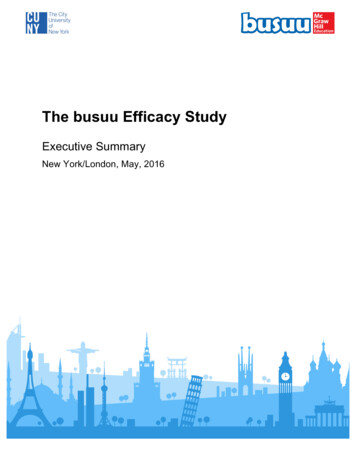
Transcription
The busuu Efficacy StudyExecutive SummaryNew York/London, May, 2016
ContextAt busuu we are confident that our methodology helps people learn to speak a newlanguage, but we wanted to prove this through an academic efficacy study.We decided to work with an independent research team in the US, who had previouslyconducted efficacy studies into Rosetta Stone1 and Duolingo2, among other languagelearning software providers. The research team consisted of Roumen Vesselinov, PhD,from City University New York and John Grego, PhD, from the University of SouthCarolina.Methodology The study ran for two months from February to April 2016.It focused on 144 Beginner-level Spanish learners in London and New York.They all studied with only busuu for at least two hours per week for eight weeks.They sat standardised entry and exit tests: WebCAPE, which measures writtenproficiency, and OPIc, which measures oral proficiency.Participants’ time online was tracked for the whole study.At the end of the eight-week study period, participants who had spent enough time onbusuu were invited to take the exit tests. Those who had studied for more than two hourstook the written test only and those who had studied for more than 16 hours took boththe written and oral tests. Participants also answered a questionnaire. Any students whohad used methods other than busuu to study had their results excluded from the finaloutcomes.Outcomes 84% of participants who sat the written test improved their result. Of those, 42%improved by the equivalent of one full college semester of Spanish or more. 10%moved up by the equivalent of 2 college semesters and 6% by 3 semesters.75% of participants who sat the oral test improved their result by one level ormore.Of those who studied for 16 hours or more on busuu, 100% made a significantimprovement to either their written test result, oral test result or both.100% of those who answered the exit survey said that they would continue touse busuu after the study ended.Participants gave busuu an average net promoter score (NPS) of 8.4.1Rosetta Stone Efficacy Study (using self-reported study s/Measuring the Effectiveness RS-5.pdf2Duolingo Efficacy Study: selinovgrego.duolingo12.pdf2
Comparison with other language learning providersCompared to other language learning providers that conducted similar efficacy studies,busuu achieved by far the best results for its students. Roumen Vesselinov, PhD, fromCity University New York stated: “Among all the language learning apps studied sofar, the efficacy of busuu is the best.”Avg gain in WebCAPE points per hour studied141212108864420Rosetta StoneDuolingobusuuAvg hours of study required to match one collegesemester60555040343022.520100Rosetta StoneDuolingobusuuOn a per hour basis, busuu achieved 3x better test results than Rosetta Stone users and50% better test results than Duolingo users on the standardized WebCAPE test.3
The busuu Methodology: White Paper, January 2016The language learning communityPage 1 of 10
The busuu Methodology: White Paper, January 2016The busuu Methodology: White PaperJanuary 2016Kirsten Campbell-Howes, Head of EducationTable of ContentsWhat is busuu? . 3How is busuu different from other language learning apps? . 3What is the busuu methodology? . 4What does the busuu syllabus cover? . 4Can busuu supplement my classroom teaching? . 5Case Study: College Students in Hungary . 5What is the busuu approach to skills? . 6What is the best way to use busuu? . 7How can students stay motivated when using busuu?. 8A manifesto for successful language learning: . 8FAQs . 9Bibliography . 10Page 2 of 10
The busuu Methodology: White Paper, January 2016What is busuu?busuu is the world’s largest social network for language learning. As of January 2016busuu’s community numbers over 60 million language learners, with up to 100,000 newlearners joining every day.busuu students can learn 12 different languages on web and mobile, using busuu’sunique combination of self-paced language courses and active social network forpracticing the languages they learn.The 12 languages available on busuu: English, Spanish, French, German, Italian, Portuguese, Chinese,Japanese, Russian, Polish, Arabic and TurkishHow is busuu different from other language learning apps?busuu is designed to provide a complete self-study and language practice environment.busuu’s courses are developed by language experts with many years of classroom teachingexperience who bring the best principles from communicative classroom teaching into theircourse design. Some of the key features include:-Interactive vocabulary and grammar lessons with audio, translation and multiplepractice exercisesAudio recordings of each vocabulary item, plus example sentences and dialogues toplace vocabulary and grammar in contextVoice recording exercises to drill pronunciation and allow students to insert theirvoice into a dialogue and get feedback from native speakersTranslations of key vocabulary, instructions and grammar tips into twelve languagesWriting exercises which receive instant corrections from native speakers in thebusuu communitybusuu-talk (web only) which allows students to find language partners and practicespeaking or text chatting with themPage 3 of 10
The busuu Methodology: White Paper, January 2016What is the busuu methodology?The busuu methodology is broadly communicative, and based on how language is taughtsuccessfully in classrooms. The focus of each exercise within a course is to give the studentsomething new (usually a word or a phrase) that they can use immediately in writing orconversation.Each lesson is grouped around a particular communicative focus (for example: introducingyourself, describing your hometown, ordering food in a restaurant). Each unit within alesson is designed to teach useful language in chunks (phrases and sentences) that thestudent can then practice reproducing in both controlled and free practice activities.Controlled practice activities include gap fills, multiple choice questions, dictation andsentence reordering activities. Free practice includes writing exercises (which are correctedby native speaking members of the community) and the busuu-talk feature on web, whichallows students to text, audio and video chat with language partners from the community.Each exerciseteaches languageyou can use inconversationimmediatelyImmediatepractice andfeedback withnative speakerscements learningShort practicesessions dailyare more effectivethan one hour perweek in classWhat does the busuu syllabus cover?The majority of language learners who come to busuu are either A1 and A2 level accordingto the Common European Framework of Reference. At busuu the aim is to bring studentsfrom A-level to upper B2 level, where they will be close to becoming proficient users1 of thelanguage they are learning.Courses contain approximately 61 lessons, and up to 340 units. Each lesson containsvocabulary and grammar units, including dialogues to show the new language in context.Vocabulary lessons are designed to include the most high frequency words in eachlanguage, reflecting research that the most common words in a language make up around1http://www.coe.int/t/dg4/linguistic/Cadre1 en.aspPage 4 of 10
The busuu Methodology: White Paper, January 201680% of all spoken and written material.2 Each lesson also includes writing and voicerecording exercises which are corrected by the native speaker community. Additionally,lessons contain a mixture of supplementary learning material such as video or media unitsfeaturing real life content from, e.g. National Geographic. busuu is constantly developingnew content partnerships with providers of real world language materials, in recognition ofthe fact that learners want to practice with the types of materials they encounter outside ofthe ‘unreal’ environments of the classroom or textbook.Can busuu supplement my classroom teaching?Yes. busuu works well as a standalone language course or as a supplementary resource forlanguage students who are already part of a university or private language school program.There are three main ways to use busuu to supplement your language teaching:1. Additional vocabulary and grammar practice2. Writing practice with native speaker corrections3. Finding language partners or penpals for additional speaking or writing practiceTeachers wishing to track their students’ progress on busuu can subscribe to reportingfeatures, which are emailed weekly and customised to include desired information such astime spent online, number and type of activities completed, time of last log in, and so on.Case Study: College Students in HungaryAn independent research study conducted at the Budapest Business College (thebiggest college in Hungary) found a statistically significant improvement in languageabilities for those students who supplemented their classroom-based languagecourses with short periods of time on the busuu app over a period of two months. Bycomparison, students in the control group (who did not have access to busuu)experienced a drop in performance in the post-study tests, indicating that busuu isuseful as a tool to aid memorisation and retention of language study material.Students who took part reported that they found busuu useful for: “vocabularyacquisition and pronunciation, chatting with native speakers, getting corrections andfeedback on writing tasks, and flexible and short learning time.”323O’Keefe, A., et al (2007)Kétyi, A., (2014)Page 5 of 10
The busuu Methodology: White Paper, January 2016What is the busuu approach to skills?busuu’s course designers have been careful to cover all the skills necessary for students toachieve fluency in communication. Many language courses focus purely on one skill, such asvocabulary acquisition, or tend to over-focus on the so-called ‘passive’ skills, such asreading, to the detriment of other skills.4 busuu aims for all its students to achieve a balancebetween all skills, using the following methods.busuu: skillsListening Nativespeakeraudio for allkey wordsDialoguesVideocontentWeekly newmediacontentReading Word andphraserecognitionVideo anddialoguetranscriptsWeekly with nativespeakersVocabulary FlashcardsInteractiveexercises topromote retentionStore your ownvocab listReview yourmistakesApple Watch app udio andvideo chatwith nativespeakersVideocontentwithsubtitlesGrammar 4SpeakingGrammar unitscreated by expertteachersPDF grammarsummaries for everylessonGrammar tipsGrammar specificexercisesVerb tables & othersupportSchellekens, P. (2011)Page 6 of 10 correctedby nativespeakersWeeklynew mediawritingexercisesPronunciation Native speakermodels for everyphraseVoice recordingexercise with nativespeaker correctionVoice recognitionexercise
The busuu Methodology: White Paper, January 2016What is the best way to use busuu?General approachesbusuu is designed to be flexible, in recognition of the fact that not everyone can or shouldlearn a language in the same way. However, busuu students broadly fall into three distinctcategories, and guidance for each group is as follows:1. Students learning their first foreign language, or students learning a language whichis very different from those they already speakStudents who are less experienced at learning a foreign language, especiallymonolingual students, are advised to study little and often, to follow each lesson insequence, and to complete all units within each lesson. Similarly, students learning alanguage very different from their own (e.g. an Italian student learning Japanese) areadvised the take the same approach.2. Students learning a third or fourth foreign languageStudents who are already bi- or trilingual may not need to study all lessons and unitsin a course. For example, a French student learning Spanish will probably not need tospend much time on Spanish grammar units, and can skip some of the familiarvocabulary units. They should focus their attention on the dialogue, voice recordingand writing exercises and on finding language partners to chat with on busuu-talk.3. Students refreshing a language they have learned beforeMany students use busuu to refresh their memories of a language they alreadylearned some time ago. Such students are advised to dip in and out of lessons, revisethe key grammar concepts and vocabulary sets they have forgotten, and to focus onfinding language partners to practice with on busuu-talk.TimingStudents are always free to cover a busuu course in the time that best suits them. Moststudents who graduate from a full busuu course (A1 to B2) take between 90 and 130 weeksto do so, with highly engaged students spending an average of 120-160 minutes on busuueach week.Students are recommended to study for a minimum of three periods of twenty minutes perweek. Students with a very regular schedule may prefer to break this down into five ormore short sessions per week, whereas some may prefer to study for several longer periodsper week. In general, little and often is recommended over longer, more infrequent studysessions. Research into the principles of spaced repetition indicates that returning regularlyto what has been learned leads to more effective memorisation and understanding oflearning materials.5 busuu’s course designers introduce new words and grammar gradually,then ensure they are repeated at regular intervals so that students can encounter themmultiple times, in different contexts. As students progress through the levels of a course,they gradually encounter more challenging vocabulary, grammar and exercises, and areexpected to spend more time reviewing the language they encounter and using it in thecommunity.5Sisti et al, (2007)Page 7 of 10
The busuu Methodology: White Paper, January 2016How can students stay motivated when using busuu?It can be very difficult to stay motivated for the amount of time it takes to learn a languageto fluency. In recognition of this, busuu courses are designed to maximise both intrinsic(self-directed) and extrinsic (external) sources of motivation.6 In particular, reward systems,feedback and social elements are optimised to increase students’ feelings of autonomy,competence and relatedness.7Students who engage fully with the busuu community, whether through competing to staytop of the leaderboard, correcting multiple writing exercises or engaging in regular busuutalk sessions, report a higher degree of motivation for their language studies in general.From their observations, the busuu team has built up a manifesto for staying motivated tolearn a language:A manifesto for successful language learning:1.2.3.4.5.6.7.8.67Set achievable goalsStudy with othersUse variety to stay motivatedAcknowledge that it takes timeDon’t beat yourself up for taking a break – just keep coming back!Focus on the skills you struggle with mostAsk for helpHave fun with the language you learnSchunk, D. et al (2014)Dornyei. Z. et al (2014)Page 8 of 10
The busuu Methodology: White Paper, January 2016FAQsWhich age groups can use busuu?busuu has students from the age of 14 to 91, but the majority are aged 20-35. Feedbackfrom busuu students indicates that busuu works well for all age groups, because it providessuch a variety of ways to learn a language.What is the linguistic aim of busuu?busuu's aim is to empower everyone in the world to learn a language. More specifically,busuu’s courses are designed to enable students to communicate in their language ofchoice. Students finish each lesson able to write and say something new in their chosenlanguage.Why should I pay for busuu when other apps are free?busuu is the only language learning app which provides a complete self-study and languagepractice environment. Most other apps focus on one or two skills (usually vocabularyacquisition). As all language teachers know, students will never achieve fluency by focusingon just one or two skills: busuu teaches them everything they need to know and then getsthem to practise the language they learned immediately, with real native speakers.My students struggle with grammar – does busuu help them with that?Yes. busuu’s courses are designed by language experts with backgrounds in linguistics andprofessional language teaching. Grammar is core to busuu courses, which contain multiplegrammar units with careful explanations, contextual examples and interactive practiceactivities to help students understand and improve their grammar quickly.Why should I send writing exercises to the busuu community – they aren’t professionallanguage teachers.busuu’s community members are language learning enthusiasts, some of whom havecorrected more than 100,000 exercises. Premium members are guaranteed to have theirwork corrected, and the more friends they make in the community, the more responsesthey get, giving them access to a wide variety of expertise. Feedback from busuu’scustomers indicates that they place a high value on the corrections they receive, preciselybecause they come from ‘real’ users of the language.Why should I correct others’ writing exercises?Correcting other people’s writing exercises is one of busuu’s most popular activities – it is agreat way to make friends in the community and users report strong feelings of satisfactionfrom helping others. It can provide a satisfying break when students are struggling withtheir own language learning, giving them the confidence and motivation to keep going, asthey share in other people’s learning journeys. It also provides insights into grammar,vocabulary choice and sentence construction which can be beneficial when learningadditional languages.Page 9 of 10
The busuu Methodology: White Paper, January 2016BibliographyDornyei, Z., Muir, C., and Ibrahim, Z. (2014) Directed Motivational Currents. In: D.Lasagabaster, A. Doiz, and J. Sierra, eds., Motivation and Foreign Language Learning. FromTheory to Practice. John Benjamins Publishing Company.Kétyi, A. (2014). Busuu Research Report. Budapesti Gazdasági Egyetem.O’Keeffe, A., McCarthy, M., and Carter R. (2007). From Corpus to Classroom: Language Useand Language Teaching. Cambridge University Press.Schellekens, P. (2011) Teaching and Testing the Language Skills of First and SecondLanguage Speakers. Cambridge ESOL.Schunk, D., Meece, J., and Pintrich, R., (2014). Motivation in Education: Theory, Research,and Applications. 4th ed. Pearson.Sisti, H., Glass, A., and Shors, T., (2007). Neurogenesis and the spacing effect: Learning overtime enhances memory and the survival of new neurons. Learning and Memory 14:368–375.Page 10 of 10
On a per hour basis, busuu achieved 3x better test results than Rosetta Stone users and 50% better test results than Duolingo users on the standardized WebCAPE test. 4 8 12 0 2 4 6 8 10 12 14 Rosetta Stone Duolingo busuu Avg gain in WebCAPE points per hour studied 55 34 22.5 0 10 20

